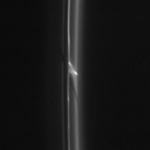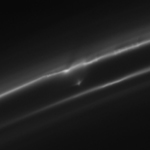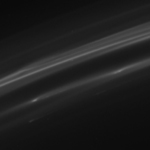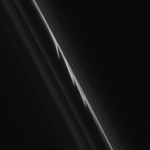 |  |  |  |
| Figure 1 | Figure 2 | Figure 3 | Figure 4 |
Click on individual image for larger viewThis set of four images obtained by NASA's Cassini spacecraft shows some of the more bizarre trails that were dragged out from Saturn's F ring by objects about a half mile (1 kilometer) in diameter. Scientists have seen more than 500 of these kinds of trails in over 20,000 images collected by Cassini from 2004 to 2011. Often the trails appear isolated (see PIA15503), but sometimes they occur in groups, leaving trails that look like the barb of a harpoon (top right image; another orientation of this same image can be found at PIA10470). The strange appearance of the top left image likely occurs because a single object has left multiple sheared trails as it passes through the core of the F ring; the sheared dark band is probably due to material that has been swept out by the object (see PIA08969). The bottom left image appears to capture several trails shearing out of peripheral strands of the F ring, showing that the objects do not even have to strike through the core to create streaks. The bottom right image appears to show trails produced as an object breaks up on its way through the F ring.
These trails, also called "mini-jets" by the scientists studying them, are typically about 25 to 112 miles (40 to 180 kilometers) long.
Scientists think the trails are created when small objects about half a mile (1 kilometer) in diameter punch through the F ring and drag icy ring particles behind them. The objects creating the trails were likely originally formed by the pull of the moon Prometheus on tiny F ring particles.
As the moon works its way around Saturn, its gravitational attraction sometimes parts channels in the icy particles of Saturn's F ring and sometimes pushes together sticky snowballs. The moon's continued progress around Saturn pulls some of the snowballs apart over time and adds material to others. These trails appear to be the telltale signs of surviving, evolved snowballs that strike through the F ring on their own. Scientists have been able to use Cassini images to track the objects and be sure they have different orbits from the F ring. The collisions occur at gentle speeds, on the order of 4 mph (2 meters per second). The F ring is the outermost of Saturn's main rings, with a radius of about 87,129 miles (140,220 kilometers).
The images were obtained by Cassini's narrow-angle imaging camera. From left to right along the top row, the images were taken on May 5, 2007 (Figure 1), and Aug. 20, 2008 (Figure 2). Along the bottom row, the images were both taken on June 10, 2009 (Figures 3 & 4). Other examples of these trails can be seen in PIA15500 and PIA15501.
The Cassini-Huygens mission is a cooperative project of NASA, the European Space Agency and the Italian Space Agency. NASA's Jet Propulsion Laboratory, a division of the California Institute of Technology in Pasadena, manages the mission for NASA's Science Mission Directorate, Washington, D.C. The Cassini orbiter was designed, developed and assembled at JPL. The imaging operations center is based at the Space Science Institute in Boulder, Colo.
For more information about the Cassini-Huygens mission visit http://saturn.jpl.nasa.gov and http://www.nasa.gov/cassini. The Cassini imaging team homepage is at http://ciclops.org.

